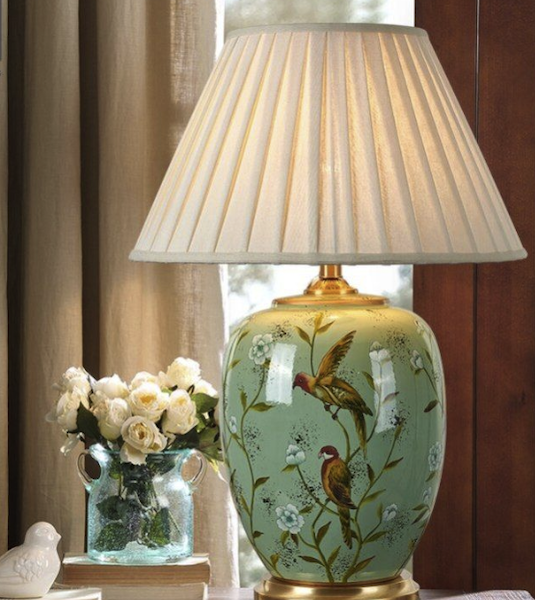Chinese table lamps are not merely functional lighting fixtures; they are exquisite pieces of art that embody centuries of cultural heritage and craftsmanship. These lamps often feature intricate designs, vibrant colors, and symbolic motifs that reflect the rich history and traditions of China. From the delicate porcelain bases to the silk shades adorned with traditional patterns, each lamp tells a story, making them a popular choice for those looking to add a touch of elegance and cultural significance to their living spaces.
The allure of Chinese table lamps extends beyond their aesthetic appeal. They serve as conversation starters, bridging the gap between modern decor and ancient artistry. As more people seek to create unique and personalized environments in their homes, the demand for these lamps has surged.
Whether used in a contemporary setting or a more traditional space, Chinese table lamps can enhance the ambiance, providing both illumination and a sense of cultural depth.
History and Tradition of Chinese Table Lamps
The Evolution of Lamp-Making
By the Tang Dynasty (618-907 AD), lamp-making had evolved into a respected craft, with artisans creating intricate pieces that showcased their skills. Throughout the dynasties, the symbolism associated with light played a significant role in the design of table lamps.
Symbols of Prosperity and Good Fortune
For instance, during the Song Dynasty (960-1279 AD), lamps often featured motifs of prosperity and good fortune, such as dragons and phoenixes. These symbols were not only decorative but also served as talismans believed to bring blessings to the household.
Advancements in Design and Materials
The Ming (1368-1644) and Qing (1644-1912) dynasties saw further advancements in lamp design, with the introduction of porcelain bases and silk shades that became hallmarks of Chinese craftsmanship.
Types of Chinese Table Lamps
Chinese table lamps come in a variety of styles, each reflecting different aspects of Chinese culture and artistry. One of the most recognizable types is the traditional lantern-style lamp, which often features a cylindrical shape and is made from materials like silk or paper. These lamps are typically adorned with intricate patterns and calligraphy, making them a stunning focal point in any room.
The soft glow emitted by these lamps creates a warm and inviting atmosphere, perfect for relaxation or entertaining guests. Another popular type is the porcelain lamp, which showcases the exquisite craftsmanship of Chinese artisans. These lamps are often hand-painted with intricate designs that may include floral patterns, landscapes, or mythical creatures.
The use of porcelain not only adds elegance but also allows for vibrant colors that can brighten up any space. Additionally, there are modern interpretations of Chinese table lamps that blend traditional elements with contemporary design, appealing to a broader audience while still honoring the rich heritage of Chinese lamp-making.
Choosing the Right Chinese Table Lamp for Your Decor
Selecting the perfect Chinese table lamp for your decor involves considering several factors, including style, size, and color scheme. First and foremost, it is essential to determine the overall aesthetic of your space. If your home features traditional decor with rich wood tones and classic furnishings, a vintage-style lamp with intricate carvings and warm colors would complement the environment beautifully.
Conversely, if your decor leans towards minimalism or modernity, a sleek porcelain lamp with clean lines and subtle patterns may be more appropriate. Size is another critical consideration when choosing a table lamp. A lamp that is too small may get lost among larger furniture pieces, while one that is too large can overwhelm a small space.
It is advisable to consider the height of your side tables or desks when selecting a lamp; ideally, the bottom of the lampshade should be at eye level when seated. Additionally, color plays a significant role in harmonizing your lamp with existing decor. Opting for colors that either match or contrast effectively with your furnishings can create a cohesive look that enhances the overall ambiance.
Placement and Lighting Tips for Chinese Table Lamps
The placement of Chinese table lamps can significantly influence the mood and functionality of a room. Ideally, these lamps should be positioned where they can provide adequate lighting for specific tasks while also serving as decorative elements. For instance, placing a lamp on a side table next to a reading chair creates an inviting nook for relaxation and reading.
In dining areas, using lamps on sideboards or console tables can enhance the dining experience by providing soft lighting that sets a warm atmosphere. When it comes to lighting tips, it is essential to consider the type of bulb used in your Chinese table lamp. Soft white bulbs are often preferred for creating a cozy ambiance, while brighter bulbs may be suitable for task-oriented areas like home offices or kitchens.
Additionally, using dimmer switches can provide flexibility in adjusting the brightness according to different occasions—whether it’s an intimate dinner party or a lively gathering with friends.
Maintenance and Care for Chinese Table Lamps
Dusting and Cleaning the Lamp Base and Shade
Regular dusting is essential to prevent dirt buildup on both the lamp base and shade. A soft microfiber cloth is ideal for this task; it effectively removes dust without scratching delicate surfaces. For porcelain lamps, it is advisable to use a damp cloth followed by a dry one to avoid water spots that can mar their appearance.
Maintaining Electrical Components
In addition to dusting, it is crucial to check the electrical components periodically. Ensure that cords are not frayed or damaged and that bulbs are replaced promptly when burnt out.
Caring for Silk Shades
For lamps with silk shades, avoid placing them in direct sunlight as this can cause fading over time. If necessary, gently clean silk shades using a soft brush or vacuum attachment on low suction to remove dust without damaging the fabric.
Incorporating Chinese Table Lamps into Different Decor Styles
Chinese table lamps possess an inherent versatility that allows them to blend seamlessly into various decor styles. In traditional settings, these lamps can serve as statement pieces that enhance the overall aesthetic through their intricate designs and rich colors. For example, pairing a classic blue-and-white porcelain lamp with antique wooden furniture creates an elegant harmony that reflects timeless sophistication.
In contrast, when incorporated into modern or eclectic decor styles, Chinese table lamps can add an unexpected twist that elevates the space’s character. A minimalist room featuring neutral tones can benefit from a bold red silk lamp adorned with gold embroidery, providing a striking focal point that draws attention without overwhelming the design. Similarly, in bohemian-inspired spaces filled with vibrant textiles and patterns, a lantern-style lamp can contribute to the layered aesthetic while maintaining its cultural significance.
Where to Buy Authentic Chinese Table Lamps
Finding authentic Chinese table lamps requires careful consideration of sources to ensure quality and craftsmanship. Specialty home decor stores often carry a curated selection of genuine pieces sourced directly from artisans in China. These stores typically prioritize authenticity and craftsmanship over mass-produced items, making them an excellent choice for discerning buyers.
Online marketplaces also offer a wide range of options; however, it is essential to research sellers thoroughly before making a purchase. Websites specializing in Asian antiques or home decor often feature authentic Chinese lamps alongside detailed descriptions and provenance information. Additionally, attending local art fairs or cultural festivals can provide opportunities to purchase directly from artisans who create these beautiful pieces, ensuring that you acquire something truly unique while supporting traditional craftsmanship.

